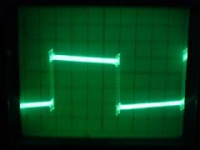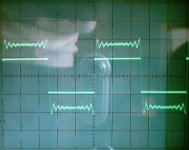i scoped my philips cd634`s outputs and to my disgust. this is what i got.
i got square waves from NCH tone gen. burn them into a cd and ran the in my cdp.
i`ve decoupled all the 5v supplies to the decoder and the servo chips, changed and biased the opamps.
what can i do to improve the situation?
i got square waves from NCH tone gen. burn them into a cd and ran the in my cdp.
i`ve decoupled all the 5v supplies to the decoder and the servo chips, changed and biased the opamps.
what can i do to improve the situation?
Yes the result is completely correct !
The DAC needs a lowpass that cuts every frequency above Samplerate/3. (eliminate aliasingdistortion)
This means all frequencies above ~15khz are cut off. This results
in a near sinewave with your 15khz squarewave.
The fact that the squarewaves look so "disgusting", shows that the
filter does a perfect job in cutting off the high freqs, and not only
smooth the signal.
Mike
The DAC needs a lowpass that cuts every frequency above Samplerate/3. (eliminate aliasingdistortion)
This means all frequencies above ~15khz are cut off. This results
in a near sinewave with your 15khz squarewave.
The fact that the squarewaves look so "disgusting", shows that the
filter does a perfect job in cutting off the high freqs, and not only
smooth the signal.
Mike
what can i do to improve the situation?
Stop listening to CDs. This Gibbs Phenomenon ringing is an artifact of the excessively narrow transition band from non-minimum phase brick wall filtering which is widely acknowledged to add coloration to the high frequencies.
The ringins are from an interpolation filter and not from a DAC. The interpolation filter reconstructs the original waveform and it has only sinuses and cosinuses  )) from a few Hz to 22.05 kHz to do this. So the edges containing upper frequencies will be distorted.
)) from a few Hz to 22.05 kHz to do this. So the edges containing upper frequencies will be distorted.
Guys what you talking about is a kind of distortion like round off the heel of trailing edges (like a passive integrator with square-wave). Just see the attached picture! This is the output waveform of a TAS5012 drived output filter. The TAS working with 8x ovesampling (interpolating, and resampling with 8x Fs(in)), the sampled signal is an 1 kHz square-wave. The TAS5012 doesn't contain a DAC.
Good Luck!
Gyula
Guys what you talking about is a kind of distortion like round off the heel of trailing edges (like a passive integrator with square-wave). Just see the attached picture! This is the output waveform of a TAS5012 drived output filter. The TAS working with 8x ovesampling (interpolating, and resampling with 8x Fs(in)), the sampled signal is an 1 kHz square-wave. The TAS5012 doesn't contain a DAC.
Good Luck!
Gyula
Attachments
As a couple others have said, the output you're seeing is perfect. CDs are a band-limited medium, and all band-limited media are subject to the Gibbs phenomenon that you're seeing.
Any introductory signal processing textbook will explain this to you. Alternatively, any university-level mathematics text with a decent explanation of Fourier analysis will also explain this.
You can design a DAC that doesn't have the Gibbs "handles", but such a DAC will actually be less accurate with respect to what is actually recorded on the CD. Filterless DACs have this property. They look intuitively nice in the time-domain on an oscilloscope to people who don't understand signal processing, but they look bad in the frequency domain.
Signal processing is an interesting field. It's worth learning more about it.
Any introductory signal processing textbook will explain this to you. Alternatively, any university-level mathematics text with a decent explanation of Fourier analysis will also explain this.
You can design a DAC that doesn't have the Gibbs "handles", but such a DAC will actually be less accurate with respect to what is actually recorded on the CD. Filterless DACs have this property. They look intuitively nice in the time-domain on an oscilloscope to people who don't understand signal processing, but they look bad in the frequency domain.
Signal processing is an interesting field. It's worth learning more about it.
thoriated said:
This Gibbs Phenomenon ringing is an artifact of the excessively narrow transition band from non-minimum phase brick wall filtering which is widely acknowledged to add coloration to the high frequencies.
Nope.
For proper reconstruction Shannon prescribes that a Sin(x)/x filter be used. This is the well-known Sinc(x) function whose impulse response ripples from the Big Bang right to Judgment Day. The ripples are a necessary condition for the reconstruction of a sampled band-limited source signal to be correct and complete. In other words: at playback these ripples are not a distortion or a deviation, insofar the oversampling filter in the CD-player approximates the theoretical Sinc function.
Now, using such filters as part of the decimation stage of an oversampling *ADC* is a different kettle of phish.
To the original poster: testing CD-players with synthesized square wave signals is a bit pointless as such signals are not band-limited, illegal in Shannon's world, and impossible to get onto a CD with a legal recording process.
They are handy for revealing the internal reconstruction filter's properties, though.
Hi all !
You are talking about ringing...
The "distorted" squarewaves you are showing are not distorted at all,
that's what a squarewave looks like after having ripped off all high freqs. (if done properly)
What is the point in reproducing a perfect squarewave, containing
frequencies up to several MHz ? It will only kill your poweramp.
A smoothed squarewave without this ringing is distorted, it contains
severe odd harmonics. (mainly 3rd and 5th harmonics)
If you learn about fouriercomponents you understand what i am talking about.
This means, a squarewave reproduced like on your images is a
perfect reproduction of squarewaves, just without deadly high freqs.
I can't believe that you are complaining about something that is really properly done...
Mike
You are talking about ringing...
The "distorted" squarewaves you are showing are not distorted at all,
that's what a squarewave looks like after having ripped off all high freqs. (if done properly)
What is the point in reproducing a perfect squarewave, containing
frequencies up to several MHz ? It will only kill your poweramp.
A smoothed squarewave without this ringing is distorted, it contains
severe odd harmonics. (mainly 3rd and 5th harmonics)
If you learn about fouriercomponents you understand what i am talking about.
This means, a squarewave reproduced like on your images is a
perfect reproduction of squarewaves, just without deadly high freqs.
I can't believe that you are complaining about something that is really properly done...
Mike
some ringing pics
Hi there,,
I have some pics of different digital/analog filters and how they relate to each other on my site:
http://www.mother-of-tone.com/timeband.htm
Charles
Hi there,,
I have some pics of different digital/analog filters and how they relate to each other on my site:
http://www.mother-of-tone.com/timeband.htm
Charles
quote:
Originally posted by thoriated
This Gibbs Phenomenon ringing is an artifact of the excessively narrow transition band from non-minimum phase brick wall filtering which is widely acknowledged to add coloration to the high frequencies.
Nope.
'Nope' what? Is there anything factual I posted that you dispute, or do you simply happen to disagree with my assertion that brick wall filters are not ideal sonically? Gibb's Phenomenon is typically referred to as 'ringing'. Also, it is not permitted to assume that my use of the word 'artifact' equates with your use of the terms 'distortion' or 'deviation', because it doesn't . IAC, such a characteristic would not be desirable in filter where an optimal settling time with a monotonic impulse function is desired, so going on about the 'perfection' of the Sinc function as implemented in an audio application filter with an absolutely flat passband response & vanishing transition band rather misses the point, AFAIC.
. IAC, such a characteristic would not be desirable in filter where an optimal settling time with a monotonic impulse function is desired, so going on about the 'perfection' of the Sinc function as implemented in an audio application filter with an absolutely flat passband response & vanishing transition band rather misses the point, AFAIC.
Originally posted by thoriated
This Gibbs Phenomenon ringing is an artifact of the excessively narrow transition band from non-minimum phase brick wall filtering which is widely acknowledged to add coloration to the high frequencies.
Nope.
'Nope' what? Is there anything factual I posted that you dispute, or do you simply happen to disagree with my assertion that brick wall filters are not ideal sonically? Gibb's Phenomenon is typically referred to as 'ringing'. Also, it is not permitted to assume that my use of the word 'artifact' equates with your use of the terms 'distortion' or 'deviation', because it doesn't
hacknet said:may i ask what is a recommended test to determine "technical" quality of a CDP?
Using a sine wave generator, record in your computer a wave file which goes from 20 to 20Khz. Keep it about 80 % of full scale.
Make a CD of that.
When you play back that CD, you will initially hear just the sine wave.
As the frequency goes up, on a poor player, you will begin to hear subharmonics..My computer sound blaster card starts to do this at about 4 Khz..it sounds like heterodyne whistling (ask some other old fart what that is...I'm gonna be in vacation mode in about 10 minutes..)
The depth of the reconstruction filter will determine the extent and amplitude of these subharmonics..since the reconstruction filter is not infinite in length, the subharmonics will be there. However, it is not very difficult to exceed the output quality of my sound blaster...
Cheers, John
- Status
- This old topic is closed. If you want to reopen this topic, contact a moderator using the "Report Post" button.
- Home
- Source & Line
- Digital Source
- awful output waveforms


